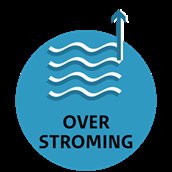What are the consequences of flooding?
Flooding can have a major impact, such as damage to buildings and infrastructure. In some cases, local residents may even be killed or injured. Exceptional floods can result in major societal crises. This page provides more information on the possible consequences of flooding.
The Delta scenarios Swift, Steam, Warm and Spacious provide four future images of how water safety and other water challenges in the Netherlands may change. All four scenarios show that water challenges will increase considerably. Their severity depends largely on how much CO2 is emitted and how much the Dutch population and economy will grow.
How strong can the impacts of flooding be?
The impact of flooding is determined by flood depth, the rate at which an area is inundated, options for evacuation, economic value, and the number of residents. Climate change is both adding to the probability of flooding and raising water levels. The latter may exacerbate the impact of flooding. Spatial developments may also affect the impact. For example, flooding may have a more severe impact if the population in an area has grown or if its economic value has risen.
How does sea level rise affect water safety?
Today, our coast is well protected against flooding. However, sea level rise can compromise this in several ways. The Sea Level Rise Knowledge Programme discusses the following consequences:
- Constant sea currents and waves cause erosion along the coastline. The sea watercarries more and more sand away from the coast, shifting our coastline more inland.
- Higher water levels and waves are an increasing burden on flood defences. If these dunes, dykes, dams and storm surge barriers are not high and strong enough, they can fail under extreme conditions. That means they can no longer hold back the water sufficiently.
- The storm surge barriers will have to close more often whensea levels This has implications for the shipping industry.
- Some of the water in our lakes and canals must be able to flow away to the sea. This is called draining. This keeps the water level in order. The options for draining become smaller as sea levels rise.
These consequences of sea level rise for water safety have been known for some time. Rijkswaterstaat and water boards are therefore already working on measures to mitigate these consequences. You can read more about this on the page How can we mitigate the risks and consequences?
